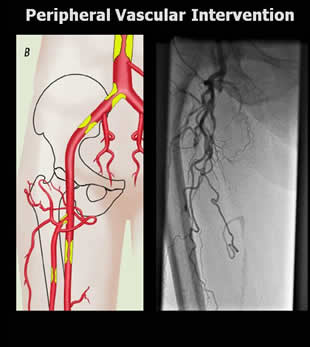
Peripheral Interventions
When patients suffer from hardening of the arteries, or atherosclerosis, their arteries are partially blocked by a substance called plaque. When these blockages occur in the legs or arms, they are called peripheral artery disease. Peripheral vascular interventions remove the plaque and restore the flow of blood through the artery. These interventions are medical specialties that treat peripheral artery diseases without surgically opening the leg or arm. Instead, the doctor uses small tools and at least one catheter. A catheter is a thin tube that is inserted into a blood vessel through a small cut, usually in the leg or arm, and threaded to the site of disease. Once in place, it acts as a tunnel, enabling the doctor to efficiently guide the tools to where they are needed.
The muscles and other tissues of the arms and legs need oxygen and nutrients to work. If the arteries that feed the arm or leg are blocked by plaque (a mixture of cholesterol, fat, calcium and other substances), the leg will not work well and may experience pain or numbness. In extreme circumstances, they may require amputation. By using a catheter, doctors avoid making large surgical cuts when they remove the blockage. As a result, procedures that rely on a catheter generally decrease pain, pose less risk of infection, avoid large scars and shorten recovery times. In some cases, the patient may go home the same day.